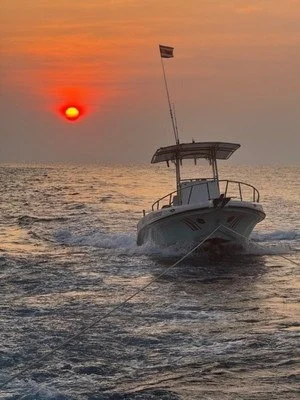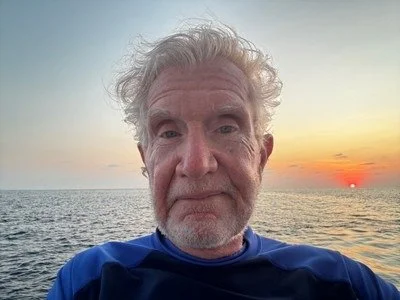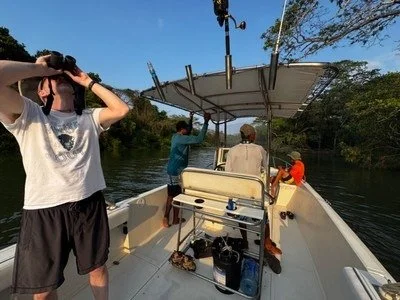Chapter 40: Day Four at Sea Jackpot
Chapter 40: Language?
Friday, March 14, 2025
Spinner dolphins locate each other using echolocation and touch. Using a wide variety of vocalization, they “speak” with clicks, squeals and whistles. Some of those sounds are of low enough frequencies that we humans can hear them. A 2020 Hawaii study found that spinner dolphin whistles last “between 0.05 and 1.28 seconds,” and can occur alone or in “burst pulses.” I heard none of that.
They hang out in families called pods and are known to mix with other families and then reform with their original units. If a pod is some number of animals up to around 30, they mix together to form occasional recorded “superpods” of up to 3,000 participants. In groups, they swim together, play together, hunt for food together and protect each other from predators such as sharks and orca. We saw no sharks. We saw no orca.
Dolphin socialization. An article I read preparing for this trip offered an interesting one-liner: a dolphin alone is not really a dolphin.
So, this morning, I made the supreme sacrifice of making sure the dolphins were not alone. Stepping off onto Valencia with my “mates” we took off for a pod that seemed a perfect match for me, the trips elder statesman. Both this mellow pod and my fellow travelers are all rooting for me. Not to catch up with them but to have a few SeaBob experiences that match their, by now, scores of SeaBob journeys.
It was a great jaunt. The calm pod was nearby, the sea swells were small, the water warm and the sky sunny. For a few minutes, neither these dolphins nor I were alone.
The experience is difficult to accurately describe. You leap into the water from the side of Valencia, holding your mask in place with your right hand so that it doesn’t fly off when you hit the water. You sink a few feet, neutralize and then rise to the surface. Immediately the clear water reveals a breathtaking (in multiple ways) view. Your SeaBob has been dropped over the side. Nearby to where you jumped, it is an easy couple of strokes to reach it and orient yourself. Right hand on the handle with the trigger and left hand on the opposite side.
Get yourself centered. Make sure your snorkel is positioned well. Use the bit of water in the bottom of your mask as a defogging tool by waving your head a bit sloshing that water over the inside of the lens. Take a breath. With your right thumb, tap the accelerator button. Once is slow. Tap again to speed up.
Next locate your partner—in this case for me it is Patrick. Either look around, at him or back at Valencia for a hand signal indicating the heading that will get you to the pod. Go.
Arriving at the pod, you do two things. You slide your body forward to facilitate tipping the nose of the SeaBob downward. That allows your mask which has been above the surface to dip below the surface. The vista that appears reveals the fact that the number of dolphin you see from the surface is but a tiny fraction of the pod members who are actually there. It looks like this. Just in case you're wondering, this is me overhead in the video that Patrick shot. He's quite good, don't you think?
Below you are hundreds, maybe thousands of these lean creatures, darting here and there, moving swiftly in and out, up and down. Next to you on both sides are more dolphin checking you out. “Who or what is this thing,” they must be asking. Clearly there are all about curiosity. They have absolutely no fear of me.
We “swim” together. If I position myself properly, I am on top of the SeaBob which is nose down—but not down enough to initiate a dive—mask in the water, snorkel tip above the surface. I can cruise, watch and enjoy and breathe easily. If I tip the nose down too far, my snorkel tip goes beneath the surface of the water and I have to stop breathing until I remedy that. If I tip the nose up too far, my mask rises out of the water and I lose the view of where the action is.
Frankly, I am not very good at this. But, for me, I am good enough. It is beautiful, marvelous and in a way inspirational. And, then, of course, it is back to the mothership.
One expression of intelligence is the ability to play.
Whales and dolphins excel at play. These spinners launch themselves into the air, spin and tumble, back flip and splash back into the water either gracefully or in awkward belly flops. These spinners have been known to complete a full seven spirals during a single leap. They will race toward our moving vessel and “surf the bow” or leap and dive at the same or faster speed of the vessel with which they are interacting. Why? It must be fun, If you could do that, wouldn’t you? There is lots of film of dolphins finding surfers in big waves and riding right alongside them. They play with plants, shells, balls, feathers, driftwood, seaweed and their own prey using them for “fun” as human babies use toys.
These lucky dolphins found, for a few minutes, a new playtoy: The silver haired abuelo riding on the bizarre what whatever-it-is thing. For a few minutes, he is interesting.
Then, as quickly as it all began, it is over. They all make a hard turn left or right and are gone.
Not so the memory of it, however, That lingers. And it is fine.
Back aboard, we head back toward Puntarenas, stopping near the Tambor Tropical Hotel in Balena Bay to anchor for the night. Before that, we take the Valencia for a short river tour to watch tropical birds and a few howler monkeys and order pizza for dinner. They delivered the pizza to Kiki I via boat. That's a first for me.





